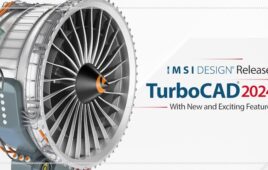Version 5 of Delcam’s PowerINSPECT software includes support for five-axis scanning with Renishaw’s REVO probe. This new release of the world’s most successful hardware-independent inspection software also features the ability to use multiple alignments within parts or assemblies, additional GD&T features, more flexible best-fit algorithms, improved CMM connectivity and more versatile report generation.

PowerINSPECT 5 is one of the first inspection software packages to support Renishaw’s REVO for the verification of both geometric and free-form shapes on CMMs. The combined solution offers faster and more accurate measurement of feature-rich parts, such as powertrain components, and complex doubly-curved surfaces, including those found in aerofoils and turbine blades.
As the five-axis REVO head is much lighter and more dynamic than the CMM, with a significantly better frequency response, it is able to follow changes in the part geometry much more quickly. In addition, five-axis scanning minimises dynamic errors caused by the inertial forces that affect the moving mass of the CMM structure.
The new PowerINSPECT release incorporates proven five-axis simulation and collision detection technology from Delcam‚’s PowerMILL CAM system. As a result, users can be confident that the inspection routines will operate safely and efficiently.
Five-axis operation for On-Machine Verification has also been enhanced, in particular by making the programming much easier. Canned strategies have been added for all standard geometric features so making it faster and simpler to generate inspection routines for prismatic parts.
PowerINSPECT’s new ability to use multiple alignments within a single part will allow independent verification of distinct areas within the component. This will make it simpler to identify the source of any error in a faulty example and so make it quicker and easier to rectify the problem.
Multiple alignments can also be important when checking assemblies of parts. They can be used to discover whether the error is in an individual component, and, if so, in which one, or whether the problem has resulted from an inaccuracy in the way in which the parts have been put together.
Inspection of more complex parts will also benefit from the enhanced best-fit options within the software. These now allow the user to prioritise the most important features in the part when identifying the most accurate alignment. For example, mating faces, which may need to be produced to a finer tolerance, can be given a higher priority.
The GD&T capability has been expanded to include symmetry, surface profile and run-out, as well as the previously-available true position, perpendicularity, angularity, parallelism and concentricity. The new options are all available within the GD&T Wizard, to easily guide the operator through the process.
Another new option is the ability to compensate for changes in the part temperature. This will be most helpful to companies using portable devices on the shop-floor, where it is impossible to maintain the temperature as consistently as can be done in a dedicated measuring area. The software includes specific expansion factors for different materials, so allowing accurate compensation allowances to be calculated.
The introduction into PowerINSPECT of I++ technology will make it easier to add the software to new hardware, especially for companies that use a variety of different devices. I++ is the standard communication format for CMMs and is supported by all major equipment manufacturers.
PowerINSPECT’s easy-to-understand reporting has always been one of the software’s most popular features. With the new release, users have been given more control over the way in which the results are displayed. The previous highly-automated reporting methods are still available but users are now able to customize reports more easily. For example, the positions and contents of results labels can be adjusted to highlight the most important measurements.
Filed Under: Software • 3D CAD, Software • CAM, ENGINEERING SOFTWARE, TEST & MEASUREMENT





Tell Us What You Think!